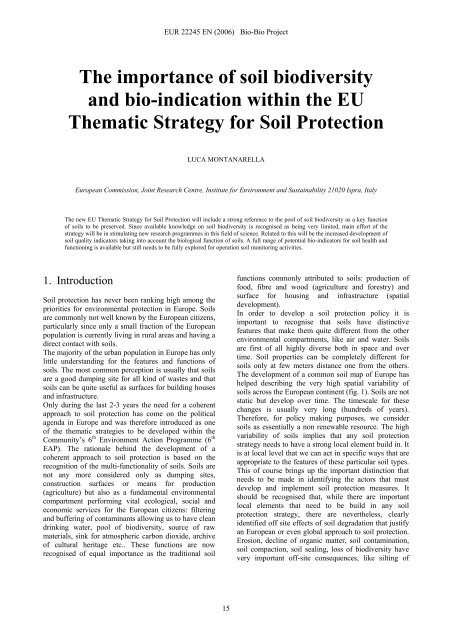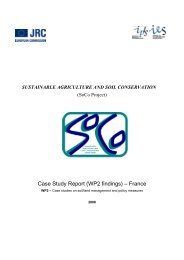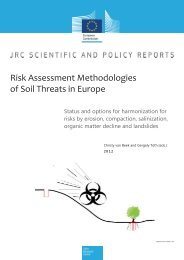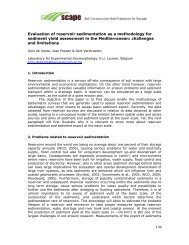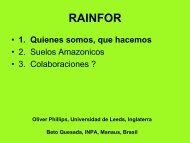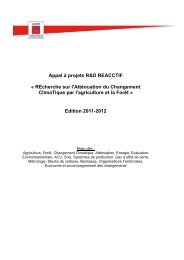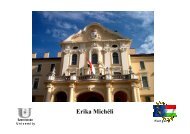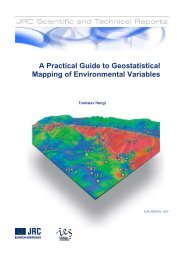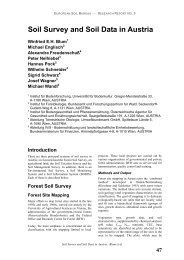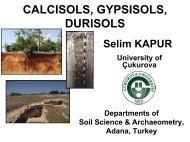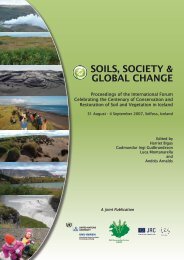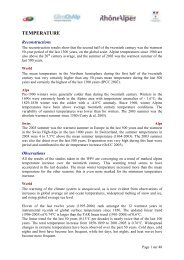Bio - Bio Project - European Soil Portal - Europa
Bio - Bio Project - European Soil Portal - Europa
Bio - Bio Project - European Soil Portal - Europa
You also want an ePaper? Increase the reach of your titles
YUMPU automatically turns print PDFs into web optimized ePapers that Google loves.
EUR 22245 EN (2006) <strong>Bio</strong>-<strong>Bio</strong> <strong>Project</strong><br />
The importance of soil biodiversity<br />
and bio-indication within the EU<br />
Thematic Strategy for <strong>Soil</strong> Protection<br />
LUCA MONTANARELLA<br />
<strong>European</strong> Commission, Joint Research Centre, Institute for Environment and Sustainability 21020 Ispra, Italy<br />
The new EU Thematic Strategy for <strong>Soil</strong> Protection will include a strong reference to the pool of soil biodiversity as a key function<br />
of soils to be preserved. Since available knowledge on soil biodiversity is recognised as being very limited, main effort of the<br />
strategy will be in stimulating new research programmes in this field of science. Related to this will be the increased development of<br />
soil quality indicators taking into account the biological function of soils. A full range of potential bio-indicators for soil health and<br />
functioning is available but still needs to be fully explored for operation soil monitoring activities.<br />
1. Introduction<br />
<strong>Soil</strong> protection has never been ranking high among the<br />
priorities for environmental protection in Europe. <strong>Soil</strong>s<br />
are commonly not well known by the <strong>European</strong> citizens,<br />
particularly since only a small fraction of the <strong>European</strong><br />
population is currently living in rural areas and having a<br />
direct contact with soils.<br />
The majority of the urban population in Europe has only<br />
little understanding for the features and functions of<br />
soils. The most common perception is usually that soils<br />
are a good dumping site for all kind of wastes and that<br />
soils can be quite useful as surfaces for building houses<br />
and infrastructure.<br />
Only during the last 2-3 years the need for a coherent<br />
approach to soil protection has come on the political<br />
agenda in Europe and was therefore introduced as one<br />
of the thematic strategies to be developed within the<br />
Community’s 6 th Environment Action Programme (6 th<br />
EAP). The rationale behind the development of a<br />
coherent approach to soil protection is based on the<br />
recognition of the multi-functionality of soils. <strong>Soil</strong>s are<br />
not any more considered only as dumping sites,<br />
construction surfaces or means for production<br />
(agriculture) but also as a fundamental environmental<br />
compartment performing vital ecological, social and<br />
economic services for the <strong>European</strong> citizens: filtering<br />
and buffering of contaminants allowing us to have clean<br />
drinking water, pool of biodiversity, source of raw<br />
materials, sink for atmospheric carbon dioxide, archive<br />
of cultural heritage etc.. These functions are now<br />
recognised of equal importance as the traditional soil<br />
15<br />
functions commonly attributed to soils: production of<br />
food, fibre and wood (agriculture and forestry) and<br />
surface for housing and infrastructure (spatial<br />
development).<br />
In order to develop a soil protection policy it is<br />
important to recognise that soils have distinctive<br />
features that make them quite different from the other<br />
environmental compartments, like air and water. <strong>Soil</strong>s<br />
are first of all highly diverse both in space and over<br />
time. <strong>Soil</strong> properties can be completely different for<br />
soils only at few meters distance one from the others.<br />
The development of a common soil map of Europe has<br />
helped describing the very high spatial variability of<br />
soils across the <strong>European</strong> continent (fig. 1). <strong>Soil</strong>s are not<br />
static but develop over time. The timescale for these<br />
changes is usually very long (hundreds of years).<br />
Therefore, for policy making purposes, we consider<br />
soils as essentially a non renewable resource. The high<br />
variability of soils implies that any soil protection<br />
strategy needs to have a strong local element build in. It<br />
is at local level that we can act in specific ways that are<br />
appropriate to the features of these particular soil types.<br />
This of course brings up the important distinction that<br />
needs to be made in identifying the actors that must<br />
develop and implement soil protection measures. It<br />
should be recognised that, while there are important<br />
local elements that need to be build in any soil<br />
protection strategy, there are nevertheless, clearly<br />
identified off site effects of soil degradation that justify<br />
an <strong>European</strong> or even global approach to soil protection.<br />
Erosion, decline of organic matter, soil contamination,<br />
soil compaction, soil sealing, loss of biodiversity have<br />
very important off-site consequences, like silting of


